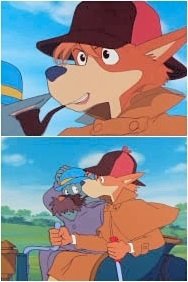October 06, 2006
Sherlock Hound
 As can be surmised from the title, the titular character is a dog. Nothing unusual there for a children's cartoon. And then you realize that everybody's a dog.
As can be surmised from the title, the titular character is a dog. Nothing unusual there for a children's cartoon. And then you realize that everybody's a dog.Now, Disney and Warner Bros. have been anthropomorphizing animated animals for a century. But characters like Bugs Bunny, Mickey Mouse and Donald Duck are presented as caricatures of human beings. That is, nothing in the world they occupy explains their existence. They're mutant creatures who happen to live like (and often alongside) human beings, along with other inexplicably sentient pigs, dogs, and rodents.
Okay, they're just cartoons, and I've got no aesthetic bone to pick with Disney or Warner Bros. on this account. My point is that, in contrast to every other bunch of anthropomorphic cartoon animals, the world of Sherlock Hound is delightfully consistent. All sentient creatures are canines (dogs, wolves, foxes, coyotes, jackals), as if somewhere back in the mists of evolutionary time, mankind's common ancestor belonged to the species Canidae.
This is a children's program, so this backstory pretty much goes without mention (except as a running gag whenever they visit a museum). But if you're simply going to replace all the humans with bipedal, doggy-looking characters, what's the point? Well, they're really cute. And the "casting" is quite clever: Holmes is appropriately a fox. Moriarty is a Little Red Riding Hood-eating breed of wolf. Watson is a Scottish Terrier. And Inspector Lestrade, naturally, is a British bulldog.
Hayao Miyazaki wrote and directed six of the first two-dozen episodes, and the series strongly reflects his influence. Miyazaki's Holmes is less Conan Doyle than Jules Verne, and the mysteries he tackles are less brain teasers than cinematic Rube Goldberg machines, something Miyazaki does very well. For a more cerebral animated Holmes, I recommend Case Closed, whose boy detective, Conan, does justice to the name.
Crunchyroll is currently streaming the series.
Labels: anime, anime reviews, miyazaki, mystery
Comments
My sister Kate discusses casting Rupert Everett vs. Jeremy Brett in the lead role (human version). Brett is of course "the standard bearer" for any future players of the part. The question she tackles is why.


